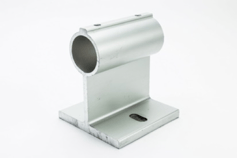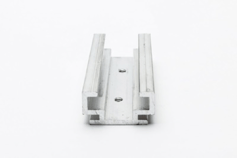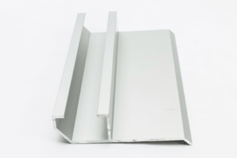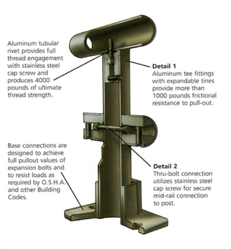Aluminum railings – lifesaving fall guards for any elevation above 31 inches -- are objects in everyday life that we often take for granted. To help maximize workplace safety those seemingly mundane elements designed for our protection should be connected by bolts rather than welds. That’s because aluminum alloys such as 6105-T5 get their strength from heat-treatment processes, and welding reduces the strength of heat-treated aluminum in the weld vicinity or Heat-Affected Zone (HAZ) by about 40%.




Simply stated, welding of aluminum handrail system components must be done with extremely precise attention to loads, strength, expected use, and codes. As state-specific Uniform Construction Codes increasingly take a back seat to the more stringent International Building Code, preventing the weakening of the HAZ is becoming a more important consideration than ever before.

Whether you’re designing, specifying, or manufacturing an aluminum handrail system, you need to account for the weakened state of welded members. According to the Aluminum Association’s Specification for Aluminum Structures, if a weld is located within 1” of any connection, the designer must analyze the connection with appropriate strength reduction. That instruction means that welds placed within 30” of the base of a small aluminum rail post will cause the post to fail when the code-required 200-lb. load is applied to the top of the post.
However, due to moment (the tendency of the post to rotate around its axis when force is applied to the post), the greatest load normally occurs at the lower part of the post. Therefore, welded connections at the top of the post are typically strong enough to meet code-specified loading requirements.
When it comes to base flanges and bottom rails that weld to the post, the strength required for welded joints must be calculated using the reduced mechanical properties required for the specific alloy within 1” of the welded area in all directions. Following this practice will significantly affect your calculations and will result in the need to reduce the spacing between posts and increase weld size and material thickness.


Alternative Solutions
Because of the potential complications related to welding handrail system components, you may want to consider Mechanical Fastening or Grout-in-Place connection methods that bolt the handrail system to the ground or to a structure depending upon the application.
Mechanical Fastening uses a non-welded base flange that fits onto the post and is held in place with setscrews. This method eliminates the strength reduction of the HAZ when using a welded base. Although slip-on flanges are plentiful for industrial applications using 1.5” diameter pipe, they are not available for all post sizes.
As for the Grout-in-Place method, it is commonly used to attach railings to concrete structures.
Regardless of the fastening method you use, we verify our engineering calculations by conducting in-house testing and also use an independent testing laboratory to verify our results.
To maximize the safety and functionality of your handrail system…